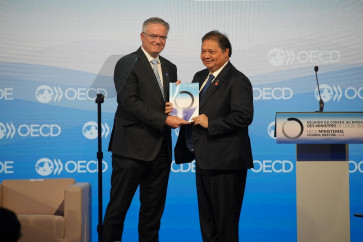Popular Reads
Top Results
Can't find what you're looking for?
View all search resultsPopular Reads
Top Results
Can't find what you're looking for?
View all search resultsFixing the minimum wage hike: Does it matter?
If labor unions and employersâ organizations find it difficult to agree on the minimum wage, which will improve welfare and business sustainability, the recently signed presidential instruction that sets a new structure for labor-intensive minimum wages should have settled the dispute
Change text size
Gift Premium Articles
to Anyone
I
f labor unions and employers' organizations find it difficult to agree on the minimum wage, which will improve welfare and business sustainability, the recently signed presidential instruction that sets a new structure for labor-intensive minimum wages should have settled the dispute.
The workers had initially demanded a 50 percent pay hike, while employers expressed concern about their ability to pay the new wages without affecting investment sustainability. The instruction requires local authorities to set minimum wages at the regional level and pegs the hike at 5-10 percent, on top of inflation.
The instruction has received a warm welcome from a number of employers, but was rejected by major trade unions who threatened to take to the streets or hold a mass strike if the 50 percent hike demand went
unheeded.
Against this backdrop, a number of questions arise. Does the instruction violate existing labor and autonomy regulations within the decentralization framework? With economic growth slowing, inflation rising, the currency's depreciation and the lending interest rate climbing, what are the implications for the investment climate if the unions insist on the 50 percent wage increase? Does the instruction amount to a win-win solution?
To assess the implications of this policy for the future, we need to take into account the region-specific labor market context, industrial relations and political economic perspectives.
Considering the minimum wage case by looking at the aggregate labor market ' determined by supply and demand ' would lead to a biased policy. Within the labor market, they need to consider informality, regional disparity, unemployment, freedom to organize and bargain collectively, as well as the state's obligation to ensure decent jobs and welfare as stipulated in the Constitution.
Yet, fixing the minimum wage is a major challenge. There is no more controversial subject among labor economists and policymakers.
The subject is complex and politically sensitive. There is no consensus in empirical research on whether a rise in minimum wage would help or hinder the economy to guide policymakers and to ensure positive labor and economic outcomes.
Workers believe the minimum wage hike is a must to allow them to achieve a 'decent standard of living' in the face of the rising cost of living. They believe the wage increase will improve productivity, therefore, benefiting businesses.
Employers, however, want to see workers' productivity increase as a condition of the minimum wage hike. They feel a higher minimum wage would hurt the economy and result in unemployment.
The presidential instruction is intended as an 'innovative government intervention' to correct (labor) market failure, as the self-regulating mechanism is not working properly. It aims to close the gap in supply and demand as well as avoid any loss in purchasing power and should be seen as 'internal guideline' for local government.
However, some argue that this top-down approach eliminates the function of the wage councils that represent government, workers and employers and are responsible for providing minimum wage recommendations at the regional level. Moreover, there is no guarantee local governments will follow the instruction, given their autonomy.
Yet, the wage councils are often dominated by government representatives who use them to gain support during local elections. Participatory and equal councils need to be ensured if the practice is to be legitimate.
The instruction has succeeded in signaling the government's support for investment sustainability, but fails to convince workers its commitment to their welfare and job protection.
This is urgently needed since statistical trends show that average real wages are below nominal wages. This has been confirmed by Jamsostek, the social security provider, which estimates that roughly 70 percent of registered workers in the scheme receive less than the regional minimum wage. It is obvious that there is an issue of non-compliance that requires regulation allowing for an inspector to use law enforcement to ensure compliance.
However, there is a potential risk in dramatically increasing the minimum wage as it may shift the decision of businesses, in particular industrial sectors, to substitute labor for more capital-intensive processes, although that is challenging for businesses when considering the rupiah's depreciation and increasing lending rates. This represents a need for more coherent industrial and employment policies.
Following the issuance of the presidential instruction, a policy outlining a new formula to determine the minimum wage has been proposed. The formula will be calculated based on extended items in the consumer price index basket using a longer time frame for application, based on information from the Central Statistics Agency, which is a good improvement. The challenge is to build consensus among stakeholders to commit to the methodology and procedure through social dialogue.
There is work to be done by the government to reduce opposition to the instruction from those who perceive it to overrule the role of the tripartite consultative forum.
Meanwhile, in signaling pro-market policies, the government needs to implement short-term 'quick wins' and strategic long-term policies, emphasizing its commitment to sustaining inclusive growth and promoting labor welfare.
One quick win could be making tripartite cooperative institutions, including the wage councils, more credible by encouraging better representation of stakeholders and increasing participation and an equal decision making processes. They should also accelerate the process of implementing regulations for the national social security system (SJSN) and social security service provider (BPJS).
Those quick wins should be followed by strategic long-term measures, such as reforming labor inspection to ensure compliance on minimum wages and revisiting regulation on minimum wage postponement; implementing universal coverage for a social protection floor, including income guarantee schemes that have replaced minimum wages mechanisms in a number of countries.
Furthermore, they require an integrated strategy for formalizing informal economy workers by combining social and employment services, as well as providing better protection for workers in rural and urban settings.
Without any concrete actions to build trust among workers through 'quick win' and strategic long-term interventions, there appears to be a consensus among workers to rally or even enact a 'general strike', which would jeopardize the economy.
_________________
The writer is a program officer with the International Labor Organization (ILO) Jakarta. The opinions expressed are his own.










